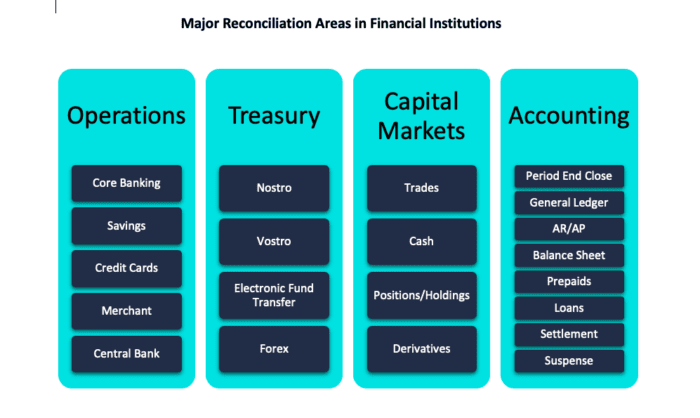Reconciliation of transactions is deemed critical for the smooth running of every financial institution. The speed and accuracy of data reconciliation can distinguish a successful institution from its counterparts. The process is primarily used to identify differences in data records and perform resolution actions. An effective reconciliation process helps financial institutions, including banks, asset managers, custodians, broker-dealers and portfolio managers, in optimal utilization of cash, proper validation of financial documents, risk management by protecting corporate assets and minimizing losses and detecting suspicious activities to be compliant with regulations. Financial institutions are currently going through a tough phase due to certain challenges posed by business and regulatory requirements. At present, reconciliations at the financial services sector are handled mostly by traditional solutions that are driven by hard-coded rules. Financial institutions have now started realizing that these solutions cannot match the speed and scale of transaction volumes and market information. They are looking to develop an integrated and automated approach to reconciliation in stark contrast to the traditional approach.

Major Reconciliation Challenges
- Exponential data growth: Digitalization of business functions has resulted in massive data generation. The generated data are becoming highly distributed and are stored in a variety of formats. Global data generation is expected to reach 180 zettabytes by 2025, up from about 10 zettabytes as of now, says IDC. In this scenario, the manual or spreadsheet approaches to reconcile data on time have proven to be ineffective.
- Errors in manual reconciliation: Errors are very common in the manual reconciliation process. As the volume of data to be reconciled increases, there are chances of higher error rates. This will impact the smooth flow of the reconciliation process and add to an organization’s operational risk.
- Ever-changing regulatory environment: The breadth and depth of reconciliation are constantly changing as regulators are coming up with new legislation. For example, the introduction of Basel III and MiFID II has significantly changed the scope of present-day reconciliation, tasking financial institutions with data sizes ranging to petabytes, and timely reporting more information about most trades with data stretching to more than 65 fields.
- Ensuring data consistency: Data inconsistency often creates issues with timely trade processing, data management, control and compliance. A well-defined and integrated process flow management should be in place for an efficient reconciliation process.
- Increasing complexity: The emergence of new asset types and structured deals has increased the complexity of transactions with more technicalities and calculations. Reconciliation of such complex deals would be very difficult to do without modifying/improving existing systems.
Reconciliation Methods
- Traditional Approach: The traditional approach deals with reconciling datasets manually. This method is still being followed by many financial institutions. In this approach, the records are manually entered, compared, analysed and the exceptions or mismatches are stored separately. The manual approach is more tiresome because of the ever-increasing volumes of data. This may also be prone to more errors due to human negligence.
- Tool-based Approach: The tool-based approach or software-driven helps overcome some of the important challenges and drawbacks in the traditional approach. By automating a large number of repetitive reconciliation workflows with pre-set matching rules, errors due to manual reconciliation can be greatly reduced. For unmatched data, the software can create exception cases that could be assigned to skilled staff. ETL tools can efficiently process and reconcile a large amount of data in a faster manner. Along with providing adequate control over data, this approach largely increases the productivity of the reconciliation staff and reduces compliance risk. However, these tools can become inefficient while adding new data sources and may require a large amount of reengineering work to adapt to a new regulation.
- Modern Approach: This approach revolves around the use of modern technologies such as artificial intelligence and machine learning to solve complex reconciliation scenarios. By employing these technologies at key data reconciliation points, a firm can unlock benefits such as significantly reduced reconciliation time, trimmed down operating costs and minimized regulatory penalties.
Need for Modern Approach
As mentioned previously, ETL tools may find it difficult to adapt to new far-reaching regulatory requirements. Tasks such as creating technical requirements, onboarding new data sources, analyzing the data and applying relevant ETL processes are very complex to handle and may take significant time to complete, leading to project delays and cost overruns. If business users continue to employ spreadsheet-based reconciliation processes to incorporate incremental data and regulatory changes, it may end up in higher costs, reduced transparency or audit-friendliness and more errors.
By using machine learning, institutions can significantly lower costs and increase the efficiency of reconciliation processes while onboarding new data sources. With the help of this technology, machines can take up slow labor-based processes in the initial onboarding stage and teach themselves the way to handle new incoming data. An ideal machine learning system, such as Tookitaki’s Reconciliation Suite, can connect to almost all data sources, including existing structured data sources and ETL layers. It can understand a wide variety of data formats such as SQL, NoSQL, csv, feed and XML. Further, it processes input data in-memory to maximize speed and ensure scalability. With the help of an in-built data engine, the system automatically learns the data sources and patterns to identify matches, highlight breaks/exceptions and provides actionable insights to resolve these breaks. The system also provides an easy-to-use user interface that helps analysts build rules and automate approvals. It also records the activities done on a case workflow in an auditable format.
When traditional and rules-based solutions increasingly become obsolete due to the increasing complexity of reconciliation processes, the prowess of machine learning to handle complexity stands out, helping organizations adhere to business and regulatory requirements while running ongoing operations smoothly. Machine learning can offer speed and performance at the optimal level without compromising on accuracy and data management standards. This technology offers a multitude of benefits in terms of improved effectiveness and efficiency and it surely has the power to replace the existing systems if implemented in the right manner.
Anti-Financial Crime Compliance with Tookitaki?




